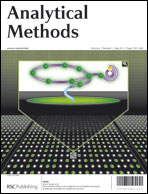Application of liquid chromatography coupled to time-of-flight mass spectrometry separation for rapid assessment of toxins in Amanita mushrooms
Abstract
Detection of unexpected contaminants in complex matrices such as food is fraught with challenges. Scientists undertaking targeted analysis will normally have sufficient time, well characterised methods at their disposal and adequate supplies of calibration standards and quality control materials. However, when faced with an unusual request, for example to rapidly detect compounds for which calibration standards are not readily available, a more generic approach may have to be used. Modern analytical approaches such as LC-UV-ToF have potential to undertake non-targeted analyses and an example is reported here in which selected mushroom toxins have been analysed and semi-quantitative measurements performed. A method was rapidly established for the detection and measurement of amatoxin and phallotoxin classes of oligo-peptide toxins in mushrooms using chromatography and time-of-flight (ToF) mass spectrometry and ultra-violet (UV)-semiquantitation techniques. Using authenticated mushrooms, a chromatographic profile for death cap mushrooms Amanita phalloides has been established and a consistent profile noted across five UK sampling sites. Representative specimens of A. muscaria, A. rubescens and A. citrina were found to be free of these specific 22 toxins (<ca. 1 mg kg−1). We estimate that 80% of the mushroom toxicity is associated with the amatoxins and using our experimental data, we extrapolate that ingestion of a single A. phalloides mushroom could indeed prove fatal. The extraction and detection method can be used to determine the accidental or malicious adulteration of food with mushroom tissues containing, amatoxins and phallotoxins but the approach has wider applications for the detection of unexpected chemicals in complex matrices and in assessing their impact on food safety.


 Please wait while we load your content...
Please wait while we load your content...